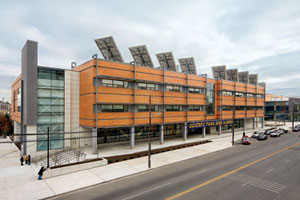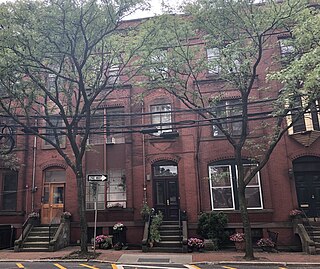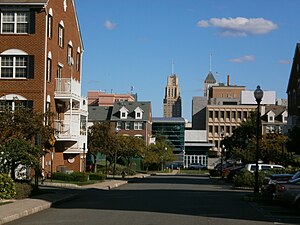
Newark is the most populous city in the U.S. state of New Jersey, the county seat of Essex County, and a principal city of the New York metropolitan area. As of the 2020 census, the city's population was 311,549. The Population Estimates Program calculated a population of 304,960 for 2023, making it the 66th-most populous municipality in the nation.

Essex County is located in the northeastern part of the U.S. state of New Jersey, and is one of the centrally located counties in the New York metropolitan area. As of the 2020 census, the county was the state's second-most populous county, with a population of 863,728, its highest decennial count since the 1970 census and an increase of 79,759 (+10.2%) from the 2010 census count of 783,969. The county is part of the North Jersey region of the state.

Jersey City is the second-most populous city in the U.S. state of New Jersey, after Newark. It is the county seat of Hudson County, and is the county's most populous city and its largest. As of the 2020 United States census, the city's population was 292,449, an increase of 44,852 (+18.1%) from the 2010 census count of 247,597, in turn an increase of 7,542 (+3.1%) from the 240,055 enumerated at the 2000 census. The Population Estimates Program calculated a population of 291,657 for 2023, making it the 72nd-most populous municipality in the nation.

New Jersey Institute of Technology (NJIT) is a public research university in Newark, New Jersey, with a graduate-degree-granting satellite campus in Jersey City. Founded in 1881 with the support of local industrialists and inventors especially Edward Weston, NJIT opened as Newark Technical School (NTS) in 1885 with 88 students. As of fall 2022 the university enrolls 12,332 students from 92 countries, about 2,500 of whom live on its main campus in Newark's University Heights district.

Science Park High School, formerly known as Science High School, is a magnet public high school located in the University Heights section of Newark in Essex County, in the U.S. state of New Jersey. The school opened in 1974 and serves students in seventh through twelfth grades as part of the Newark Public Schools. The school is for college-bound students, offering many Advanced Placement equally rigorous honors courses and as of the 2013-14 school year, IB classes to those who choose to apply.

Rutgers University–Newark is one of three regional campuses of Rutgers University, a public land-grant research university consisting of four campuses in New Jersey. It is located in Newark. Rutgers, founded in 1766 in New Brunswick, is the eighth oldest college in the United States and a member of the Association of American Universities. In 1945, the state legislature voted to make Rutgers University, then a private liberal arts college, into the state university and the following year merged the school with the former University of Newark (1936–1946), which became the Rutgers–Newark campus. Rutgers also incorporated the College of South Jersey and South Jersey Law School, in Camden, as a constituent campus of the university and renamed it Rutgers–Camden in 1950.

Essex County College (ECC) is a public community college in Essex County, New Jersey, United States.

Warren Street/NJIT station is one of four underground stations on the Newark City Subway Line of the Newark Light Rail. It is the furthest station from Downtown Newark that is underground. The station is owned and service is operated by New Jersey Transit. The station has entrances on both sides of Lock Street, just north of Warren Street in University Heights. It is decorated with beige tiles and colored tiles for borders, mosaics and street indicator signs. This station is not wheelchair accessible.

Norfolk Street station is an open-cut station on the Newark City Subway Line of the Newark Light Rail, and the first following the line leaving the Raymond Boulevard tunnel. It is located on Norfolk Street just south of Central Avenue in University Heights.
Dr. Robert W. Van Houten was the 4th President of New Jersey Institute of Technology (NJIT) from 1947 until 1970.

Eberhardt Hall, originally the Newark Orphan Asylum, is the oldest building at the New Jersey Institute of Technology (NJIT). It is located at 323 Martin Luther King Jr. Blvd., in the University Heights section of Newark, Essex County, New Jersey, United States. Built in 1856-57 its original purpose was to serve as a home for Newark's orphans. Eberhardt Hall is listed in the National Register of Historic Places and is a beautiful example of 19th-century Gothic Victorian architecture, in conjunction with 15th- and 16th-century castle design.

The James Street Commons Historic District is a 65-acre (26 ha) historic district located in Newark, Essex County, New Jersey, United States. The district was added to the National Register of Historic Places on January 9, 1978, for its significance in architecture, art, community planning and development, education, industry, and social history. There was a small boundary increase on September 22, 1983.

Weequahic is a neighborhood in the city of Newark in Essex County, in the U.S. state of New Jersey. Part of the South Ward, it is separated from Clinton Hill by Hawthorne Avenue on the north, and bordered by the township of Irvington on the west, Newark Liberty International Airport and Dayton on the east, and Hillside Township and the city of Elizabeth on the south. There are many well maintained homes and streets. Part of the Weequahic neighborhood has been designated a historic district; major streets are Lyons Avenue, Bergen Street, and Chancellor Avenue. Newark Beth Israel Medical Center is a major long-time institution in the neighborhood.

Vailsburg is a neighborhood in the city of Newark in Essex County, in the U.S. state of New Jersey. Part of the West Ward, its elevation is 280 feet (85 m). As of 2000, Vailsburg had a population of 34,348. The Vailsburg section of Newark is on a hill which closely aligns with the suburban and park areas outside it. Vailsburg includes the two smaller neighborhoods of upper Vailsburg and lower Vailsburg, both of which have Sanford Avenue as a focal point. Upper Vailsburg is closer to Maplewood and South Orange.
American History High School is a magnet public high school in the University Heights neighborhood of Newark, in Essex County, in the U.S. state of New Jersey, operating since its establishment in 2006 as part of the Newark Public Schools. Operating together with the Gilder Lehrman Institute of American History, the New Jersey Historical Society and Rutgers–Newark, American History High School's magnet program is designed to take advantage of the city's place in American history and its access to academic, cultural and civic resources as part of a college preparatory curriculum designed to assist students in understanding local, state and national history and preparing each student to attend college.
Started in 1971, the Council for Higher Education in Newark (CHEN) consisted of four public institutions of higher learning in Newark, New Jersey including: New Jersey Medical School - Rutgers, New Jersey Institute of Technology (NJIT), Rutgers–Newark, and Essex County College. The schools are all located in the city's University Heights neighborhood which borders downtown.
Sports in Newark, New Jersey, the second largest city in New York metropolitan area, are part of the regional professional sports and media markets. The city has hosted many teams and events, though much of its history is without an MLB, NBA, NHL, or NFL team in the city proper. Two venues in the northeastern New Jersey metro region, Prudential Center and Riverfront Stadium (closed), are in Downtown Newark. Red Bull Arena is just across the Passaic River in Harrison. The Meadowlands Sports Complex is less than 10 miles away from Downtown and reached with the Meadowlands Rail Line via Newark Penn Station or Broad Street Station.
The Central King Building at the New Jersey Institute of Technology (NJIT) was originally built as the Central Commercial and Manual Training School. It housed a co-ed college/vocational preparatory school which provided students with "a happier and more healthful environment than their own homes". It was constructed under the supervision of the Newark School Board's Head of Construction Department, Ernest F. Gilbert. It housed Central High School until its purchase in 2010 by NJIT. Built in the Collegiate Gothic style, it was renovated under a New Jersey state grant and reopened as a university building and STEM counseling center on April 13, 2017.
James LeRoy Baxter was a dentist / oral surgeon and state legislator in New Jersey. He was elected to represent Essex County, New Jersey in the New Jersey General Assembly in 1928.

















